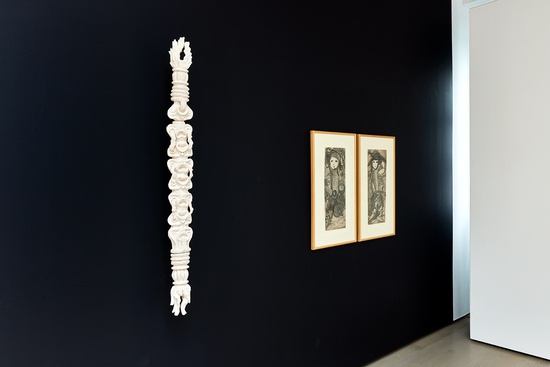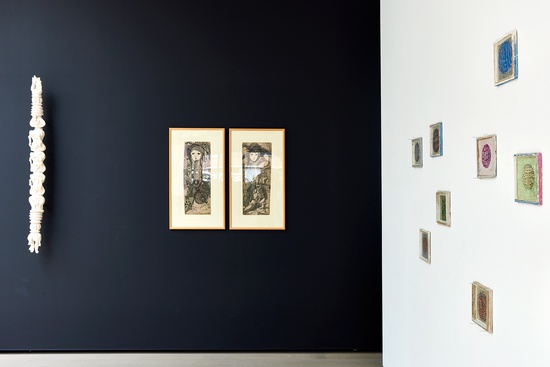13. Madge Gill
Madge Gill
(1937)
Female faces, white like moons, peek out from scribbles of black ink on paper. Curious circles of negative space, they immediately draw us in with their haunting, inscrutable expressions: sadness? Surprise? Weariness? These are not hollow emblems of female beauty, but creatures with a great psychological weight and enigmatic character. The figures appear stopped in their tracks, deep in thought, but swaddled in fabric and trimmings: netting, lace, florid headpieces, flowing ribbons and embellishments are all suggested at, though difficult to differentiate from sketchy and zigzagging background patterning. In one drawing, a chorus of faces gathers below the main figure, looking up at her with a vacant and confused expression.
These haunting female faces appear again and again in the thousands of ink drawings produced by the English spiritualist Madge Gill (1882–1961). An untrained artist, Gill began producing this work in 1920, after she first began channelling her spirit guide, Myrninerest. This dramatic occurrence took place in the aftermath of several traumatic life events, including the premature death of a son, a stillborn daughter and a life-threatening illness that left her with one eye. Myrninerest, according to Gill, was the author of all her artistic creations, which included weaving, crocheting, automatic writing and piano playing as well as her extensive body of drawings. She is said to have worked prolifically, secretively, and by candlelight—often working through the night in a frenzied trance. Though Gill exhibited in amateur exhibitions during her lifetime, she refused to sell her artworks, arguing Myrninerest was their true owner—and so vast swathes of her work were discovered only after her death, stashed away in cupboards and under the bed.
Gill’s forlorn female figures, like those pictured here, bear the hallmarks of 1920s fashions. With round faces, small Cupid’s bow mouths and large childlike eyes, they resemble strung-out flappers with dilated pupils and distant expressions. Hair is gathered in curls at the side of their faces, perhaps under some kind of headband or bonnet; beauty spots are pencilled on and eyes are painted with make-up. There’s something gauzy, tactile about these drawings—as if Gill has woven thread with the pen. Their sumptuous trappings feel at odds with their spartan black ink, and frantic, scratchy, almost punky, style of drawing. Each portrait seems deeply imbued with hidden meaning, and the identity of this female figure has been much speculated on since the artist’s death: are they self-portraits, imaginings of potential futures for Gill’s stillborn daughter, or representations of Myrninerest herself? Silent about their origin, these gothic girls float by weightlessly, as if trapped in a spirit plane inhabited only by Gill’s obsessive automatic drawings.
Text by Rosa Abbott



